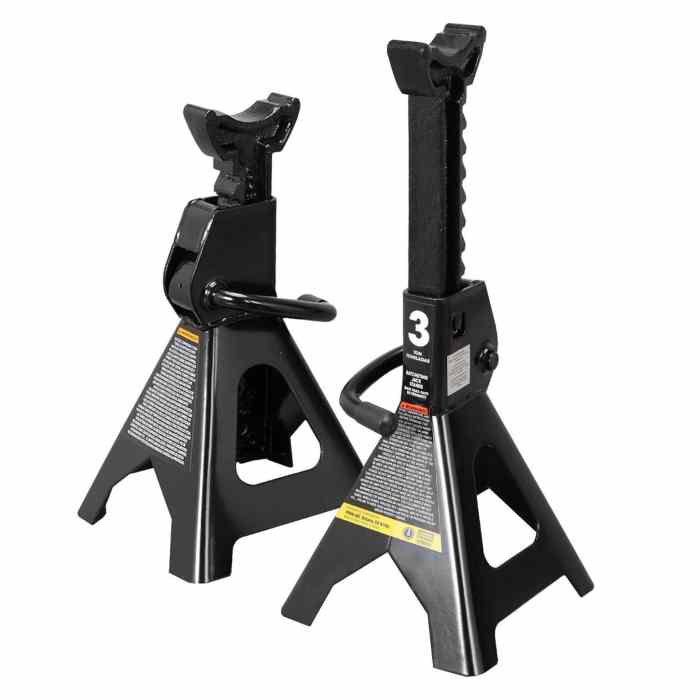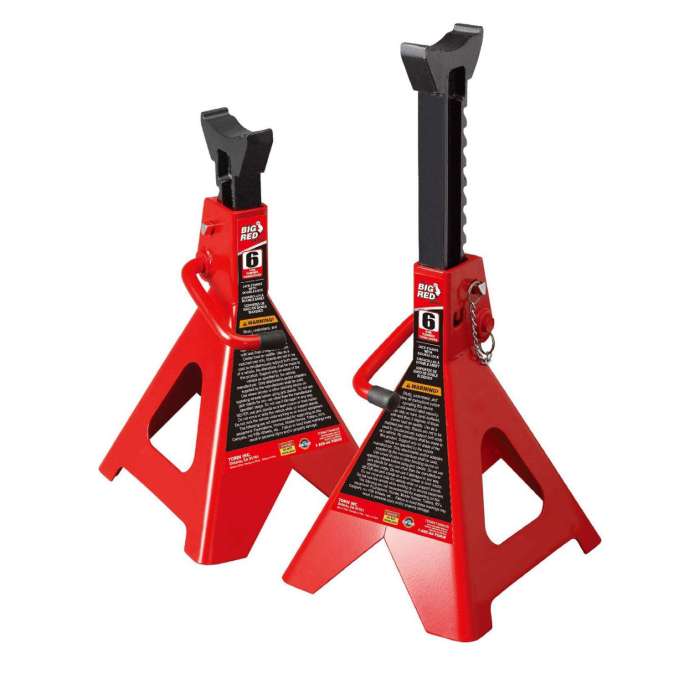Best jack stands for home garage? Choosing the right ones is crucial for safe and efficient DIY car maintenance. This isn’t just about lifting your car; it’s about ensuring your safety and the longevity of your vehicle. We’ll dive into the different types of jack stands, their weight capacities, essential safety features, and how to choose the perfect set for your home garage needs, covering everything from steel vs.
aluminum to proper maintenance and storage tips.
From understanding weight ratings and safety protocols to exploring top brands and models, we’ll equip you with the knowledge to make an informed decision. Whether you’re a seasoned mechanic or a weekend warrior, this guide will help you find the best jack stands to keep your projects running smoothly (and safely!).
Types of Jack Stands
Choosing the right jack stands for your home garage is crucial for safety and efficiency. Different types cater to various needs and budgets, so understanding their characteristics is key to making an informed decision. This section will break down the common types, highlighting their strengths and weaknesses to help you find the perfect fit for your projects.
Steel Jack Stands
Steel jack stands are the workhorses of the garage. Their robust construction offers superior strength and durability, making them ideal for heavy-duty lifting tasks. They typically boast higher weight capacities than their aluminum counterparts. However, their significant weight can make them less portable, and they’re prone to rust if not properly maintained. The thicker steel construction contributes to their stability, but also increases their overall weight.
Many steel jack stands feature a simple, reliable pin-and-hole locking mechanism. Regular inspection for wear and tear on the locking mechanism is essential for safety.
Aluminum Jack Stands
Aluminum jack stands offer a lighter-weight alternative to their steel counterparts. This makes them easier to transport and maneuver, a significant advantage for those with limited storage space or who frequently move their stands. While generally less durable than steel, high-quality aluminum stands can still handle significant weight, although typically less than steel options of comparable size. Their lighter weight can sometimes translate to slightly less stability, particularly on uneven surfaces.
Aluminum stands are also less susceptible to rust, making them a good choice for damp environments. The locking mechanisms on aluminum stands can vary, so it’s important to check the design and reliability of the locking system before purchase.
Heavy-Duty Jack Stands
Heavy-duty jack stands are designed for the most demanding tasks. These are usually made from extra-thick steel and feature reinforced construction, significantly increasing their weight capacity and stability. They’re essential for working on heavier vehicles or equipment, and are built to withstand extreme loads and prolonged use. The downside is their substantial weight and bulkier design, making them less convenient for frequent use or limited storage.
Safety features often include extra-large base plates for improved stability and robust locking mechanisms designed for heavy loads. Expect a higher price point compared to standard steel or aluminum jack stands.
So you’re looking for the best jack stands for your home garage? Solid jack stands are crucial for any DIY car work, especially if you’re tackling something like a wheel bearing replacement. If you notice any weird noises or vibrations while driving, it might be time to check for issues; you can read up on the symptoms of a bad wheel bearing to be sure.
Once you’ve got the right stands, you’ll be ready to safely lift your car and get that repair done.
Compact Jack Stands
Compact jack stands prioritize portability and storage efficiency without sacrificing safety. They are often made from lighter materials, such as aluminum, and feature a smaller footprint. While their weight capacity may be lower than heavy-duty stands, they are perfectly suitable for working on lighter vehicles or smaller projects. Their compact design is ideal for users with limited garage space or those who frequently transport their tools.
These stands often incorporate clever design features, such as foldable arms or integrated carrying handles, for enhanced convenience. However, users should always carefully check the weight capacity to ensure it matches their needs.
Jack Stand Comparison Table
| Type | Features | Price Range (USD) | Weight Capacity (lbs) |
|---|---|---|---|
| Steel | Durable, High Weight Capacity, Prone to Rust | $20 – $100+ | 3-12 tons+ |
| Aluminum | Lightweight, Portable, Less Durable | $30 – $80+ | 1-6 tons |
| Heavy-Duty Steel | Extremely Durable, Very High Weight Capacity, Heavy | $80 – $200+ | 6-20 tons+ |
| Compact Aluminum | Lightweight, Portable, Lower Weight Capacity | $25 – $60 | 1-3 tons |
Capacity and Weight Ratings

Choosing the right jack stands is crucial for safety when working on your car. One of the most important factors to consider is the jack stand’s weight capacity rating. This rating dictates the maximum weight the stand can safely support, and selecting the wrong capacity can have serious consequences.Understanding weight capacity is about more than just your vehicle’s curb weight.
So you’re looking for the best jack stands for your home garage? Solid jack stands are crucial for any serious DIY mechanic, providing a safe and stable platform for working underneath your car. This is especially important for more involved jobs, like replacing parts, such as if you check out this guide on how to replace a fuel pump at home , you’ll see how essential proper jack stand placement is.
Ultimately, investing in quality jack stands ensures your safety and makes those home garage repairs much smoother.
You need to account for the added weight of any components you might be removing or adding during the repair, as well as the uneven distribution of weight when the vehicle is lifted. Underestimating the required capacity can lead to catastrophic failure, resulting in vehicle damage, injury, or even death.
Determining Required Weight Capacity
To determine the necessary weight capacity, you need to consider several factors. First, find the Gross Vehicle Weight Rating (GVWR) of your vehicle. This information is usually found in your owner’s manual or on a sticker located inside the driver’s side doorjamb. The GVWR represents the maximum weight of the vehicle when fully loaded, including passengers, cargo, and fluids.
However, this is just a starting point.For example, let’s say your vehicle’s GVWR is 3500 lbs. You’re planning to remove the engine, which weighs approximately 400 lbs. You should also consider the weight of any tools or parts you’ll be working with. If you estimate an additional 100 lbs for tools and parts, your total weight becomes 4000 lbs (3500 lbs + 400 lbs + 100 lbs).
Therefore, you’ll need jack stands with a weight capacity significantly higher than 4000 lbs, perhaps even a safety factor of 150% or more. This ensures a sufficient margin of safety.
Consequences of Using Undersized Jack Stands
Using jack stands with insufficient weight capacity is incredibly dangerous. The stands could collapse under the weight of the vehicle, causing the vehicle to fall and potentially resulting in serious injury or death. Even if the stands don’t completely fail, they could bend or deform, compromising their stability and increasing the risk of a catastrophic failure. It’s far better to err on the side of caution and choose jack stands with a significantly higher weight capacity than you anticipate needing.
Factors to Consider When Determining Necessary Weight Capacity
It’s essential to consider several factors when determining the necessary weight capacity for your jack stands. A simple calculation based solely on the vehicle’s weight might be insufficient.
- Gross Vehicle Weight Rating (GVWR): This is the maximum weight of the vehicle when fully loaded.
- Additional Weight: Account for the weight of any parts or components you’ll be removing or adding during the repair.
- Tools and Equipment: Factor in the weight of any tools, equipment, or materials you’ll be using while the vehicle is lifted.
- Safety Factor: Always use jack stands with a weight capacity significantly exceeding the calculated weight. A safety factor of 150% or more is often recommended.
- Uneven Weight Distribution: Consider that the weight distribution might not be even when the vehicle is lifted. The weight on each jack stand might be higher than you initially calculate.
Safety Features and Practices
Choosing the right jack stands is only half the battle; understanding and implementing safe practices is crucial for preventing accidents. Improper use can lead to serious injury or even death, so paying close attention to safety features and procedures is paramount. This section will detail essential safety features to look for and provide a step-by-step guide for safe usage.
Critical Safety Features of Jack Stands
Several key features significantly enhance the safety of jack stands. These features contribute to stability, prevent accidental collapse, and offer increased user confidence. Investing in stands with these features is a worthwhile safety precaution.
- Wide Base: A wider base provides greater stability and reduces the risk of tipping. Look for stands with a substantial footprint to distribute the weight effectively.
- Positive Locking Mechanism: This mechanism ensures the stand remains securely in the raised position and prevents accidental lowering. Avoid stands with flimsy or unreliable locking systems.
- Safety Pins or Ratchets: These secondary locking mechanisms add an extra layer of protection, preventing the stand from collapsing even if the primary locking mechanism fails. These should always be engaged.
- Sufficient Height Adjustment: The jack stands should have enough height adjustment range to accommodate various vehicle types and lifting needs. Ensure the stands can reach the necessary height without being overly extended.
- Durable Construction: Jack stands should be made of high-quality, heavy-duty steel to withstand the weight of a vehicle. Check for signs of wear or damage before each use.
Safe and Proper Use of Jack Stands
Using jack stands correctly is non-negotiable. Failure to follow these steps can result in catastrophic consequences.
- Preparation: Ensure the vehicle is parked on a level, stable surface. Engage the parking brake firmly. Chock the wheels opposite the ones being lifted to prevent rolling.
- Lifting the Vehicle: Use a suitable jack to lift the vehicle to the desired height. Ensure the jack is properly positioned and stable under the vehicle’s designated lifting points.
- Positioning the Jack Stands: Carefully position the jack stands under the vehicle’s frame, ensuring they are firmly seated and stable. Consult your vehicle’s owner’s manual for the correct jacking points.
- Lowering the Vehicle: Slowly lower the vehicle onto the jack stands, ensuring they are evenly supporting the weight. Never work under a vehicle supported solely by a jack.
- Securing the Stands: Once the vehicle is resting on the jack stands, double-check that all locking mechanisms and safety pins are securely engaged. Visually inspect the stands for stability.
- Post-Work: Before removing the jack stands, carefully raise the vehicle using the jack. Remove the stands slowly and methodically. Always lower the vehicle gradually.
Hazards of Improper Jack Stand Use and Mitigation
Improper use of jack stands can lead to severe accidents. Understanding these hazards and implementing preventative measures is crucial.
- Collapse: Using damaged or overloaded stands can lead to collapse, potentially resulting in serious injury or death. Regularly inspect stands for damage and never exceed their weight capacity.
- Tipping: Placing stands on uneven surfaces or not properly securing them can cause tipping. Always use a level surface and ensure the stands are stable.
- Vehicle Slippage: Failure to properly secure the vehicle can cause it to slip off the stands. Always use chocks and ensure the vehicle is properly supported.
- Improper Lifting Points: Lifting the vehicle at incorrect points can cause damage to the vehicle or lead to instability. Always consult your vehicle’s owner’s manual.
Safety Precautions Checklist
Before beginning any work involving jack stands, review this checklist:
- Inspect jack stands for damage.
- Ensure jack stands are rated for the vehicle’s weight.
- Park on a level, stable surface.
- Engage the parking brake.
- Chock the wheels.
- Use proper lifting points.
- Securely position jack stands.
- Engage all locking mechanisms and safety pins.
- Slowly lower the vehicle onto the stands.
- Never work under a vehicle supported only by a jack.
- Raise the vehicle before removing stands.
Maintenance and Storage
Proper maintenance and storage of your jack stands are crucial for ensuring their longevity and, more importantly, your safety. Neglecting these aspects can lead to premature wear, compromised stability, and potentially dangerous situations during your next DIY project. Taking a few minutes to perform routine checks and store them correctly will significantly extend their lifespan and help prevent accidents.Regular maintenance is key to preventing accidents and ensuring the jack stands are always ready when you need them.
Ignoring this can lead to unexpected failures during critical lifting operations. This section covers cleaning, lubrication, and inspection procedures to keep your jack stands in top shape.
Jack Stand Cleaning and Lubrication
Clean your jack stands after each use. Wipe down the entire stand with a clean cloth, removing any dirt, grease, or debris. Pay close attention to the moving parts, such as the ratchet mechanism and the locking pin. For stubborn grime, a mild detergent and water solution can be used, followed by thorough rinsing and drying. After cleaning, apply a light coat of lubricant, such as lithium grease, to the moving parts.
This will reduce friction and ensure smooth operation, preventing premature wear and tear. Avoid using penetrating oils, as these can damage the rubber or plastic components.
Inspecting Jack Stands for Wear and Tear
Regular inspection is vital for identifying potential problems before they become safety hazards. Before each use, visually inspect the jack stands for any signs of damage, such as bent or cracked components, excessive rust, or damage to the rubber pads. Check the ratchet mechanism for smooth operation and ensure the locking pin engages securely. Pay close attention to the base and the contact points with the vehicle.
Any signs of significant wear or damage necessitate immediate replacement. For example, a bent base could compromise stability, while cracked welds could lead to catastrophic failure under load. A worn rubber pad might slip, resulting in an unsafe working environment.
Storage Practices for Jack Stands
Proper storage prevents damage and ensures easy access when needed. Store jack stands in a clean, dry location, away from direct sunlight and moisture. Consider using a dedicated storage rack or shelf to keep them organized and prevent accidental damage. Avoid stacking jack stands on top of each other, as this can put stress on the components and potentially damage them.
Keeping them clean and dry will prevent rust and corrosion, extending their useful life. A designated storage area also prevents accidental damage and keeps them readily accessible for your next project.
Infographic: Maintaining and Storing Jack Stands
The infographic would be a visually appealing, single-page guide. The top half would show a jack stand with arrows pointing to key areas for inspection (base, ratchet mechanism, locking pin, rubber pad). Each arrow would be labeled with a brief description of what to check for (e.g., “Check for cracks or bends,” “Ensure smooth operation,” “Verify secure engagement,” “Inspect for wear”).
The bottom half would depict proper storage, showing jack stands neatly organized on a rack or shelf, away from moisture and direct sunlight. A small text box would emphasize the importance of regular cleaning and lubrication with appropriate products. The overall design would use bold colors and clear, concise labels to ensure easy understanding.
Top Brands and Models: Best Jack Stands For Home Garage

Choosing the right jack stands can feel overwhelming given the variety available. This section dives into some top brands and specific models, comparing their features, pricing, and user feedback to help you make an informed decision. We’ll focus on models suitable for the average home garage mechanic.Selecting the right jack stand involves considering several factors beyond just the weight capacity.
Features like the stand’s construction material, safety mechanisms, and overall design contribute significantly to its performance and longevity. User reviews provide invaluable insight into real-world experiences, offering a perspective that goes beyond manufacturer specifications.
Reputable Jack Stand Brands and Model Comparisons
Several brands consistently receive positive feedback for their jack stands. These include Arcan, Torin, QuickJack, and Powerbuilt. While other brands exist, these offer a good representation of the market, spanning various price points and features.
Arcan Jack Stands, Best jack stands for home garage
Arcan is known for its focus on durability and safety. Their heavier-duty models often feature a robust steel construction and multiple safety features. User reviews generally praise their stability and reliability. One specific model, often cited, features a wide base for increased stability and a positive locking mechanism. The price point is generally higher than some competitors, reflecting the emphasis on quality.
Torin Jack Stands
Torin offers a broader range of jack stands, catering to different needs and budgets. Their models often balance affordability with decent quality. While not always as heavy-duty as Arcan, many Torin models receive positive reviews for their ease of use and satisfactory performance for typical home garage tasks. Some models incorporate features like a wider base for stability and a ratcheting mechanism for easy height adjustment.
Their price is typically more competitive than Arcan.
QuickJack
QuickJack stands apart by offering a different type of jack stand: a vehicle lift system. These are significantly more expensive than traditional jack stands, but offer a much quicker and easier way to lift a vehicle. User reviews highlight the convenience and speed of QuickJack systems, though the high initial investment is a major factor. Features include a hydraulic lift system and often a built-in safety mechanism to prevent accidental lowering.
Powerbuilt Jack Stands
Powerbuilt often represents a more budget-friendly option. Their jack stands are generally well-regarded for their value, though they might not offer the same level of heavy-duty construction as Arcan. User reviews are generally positive for light to moderate use, but some users note a slightly less robust feel compared to higher-priced options. They often incorporate basic safety features, such as a positive locking mechanism.
Jack Stand Model Comparison Table
| Brand | Model (Example) | Features | Approximate Price (USD) | Average Customer Rating (out of 5) |
|---|---|---|---|---|
| Arcan | (Specific Arcan model number) | Heavy-duty steel construction, wide base, positive locking mechanism | $100 – $150 | 4.5 |
| Torin | (Specific Torin model number) | Steel construction, ratcheting height adjustment, wider base | $50 – $80 | 4.0 |
| QuickJack | (Specific QuickJack model number) | Hydraulic lift system, quick lift/lower, built-in safety features | $1000 – $2000+ | 4.2 |
| Powerbuilt | (Specific Powerbuilt model number) | Steel construction, positive locking mechanism, budget-friendly | $30 – $60 | 3.8 |
Choosing the Right Jack Stands for Your Needs
Picking the perfect jack stands for your home garage isn’t just about grabbing the cheapest pair; it’s about ensuring your safety and the successful completion of your vehicle maintenance projects. Several factors need careful consideration to find the right fit for your needs and budget. Ignoring these could lead to accidents or inadequate support for your vehicle.Choosing the right jack stands involves careful consideration of several key factors.
These factors work together to determine the optimal jack stand for your specific needs and garage environment. Understanding these will help you make an informed purchase that prioritizes safety and efficiency.
Jack Stand Height and Capacity Determination
Determining the correct height and weight capacity is crucial for safe vehicle lifting. The height should allow for sufficient clearance to work comfortably underneath your vehicle without forcing awkward postures. The capacity must exceed the weight of your heaviest vehicle, including any added weight from fluids or cargo. For example, a compact car might only need stands with a 3-ton capacity, while a heavy-duty truck might require 6-ton stands.
Always check your vehicle’s owner’s manual for its curb weight, and remember to add an additional safety margin.
Recommended Jack Stands for Different Vehicle Types
Different vehicles have different weight distributions and lifting points. Compact cars and SUVs often require shorter, lighter-duty stands, while larger trucks and vans may necessitate taller, heavier-duty models. For instance, a set of 3-ton jack stands would likely suffice for most sedans and smaller SUVs. However, larger trucks and heavier vehicles might need 6-ton or even higher capacity stands.
Always consult your vehicle’s owner’s manual to determine the correct lifting points and the vehicle’s weight.
Choosing Jack Stands Based on Frequency of Use and Budget
The frequency of use significantly influences your jack stand selection. If you only work on your vehicle occasionally, a less expensive, basic set might suffice. However, for frequent use, investing in a higher-quality, more durable set is advisable. Budget plays a crucial role too. While higher-priced stands often offer superior features and durability, budget-friendly options are available that still provide adequate safety and functionality.
Consider the balance between your budget and your needs, prioritizing safety above all else.
Epilogue

Ultimately, selecting the best jack stands for your home garage boils down to prioritizing safety and choosing a model that meets your specific needs and vehicle weight. By considering factors like weight capacity, safety features, and ease of use, you can confidently tackle your automotive projects knowing you have the right tools for the job. Remember, a little research goes a long way in ensuring a safe and successful DIY experience.










